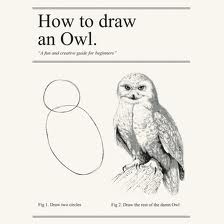 I recently read a Seth Godin blog that compared leadership and business advice to being asked to draw an owl. The article suggests that the approach typical of much business advice would be analogous to saying that there are two steps to drawing an owl.
I recently read a Seth Godin blog that compared leadership and business advice to being asked to draw an owl. The article suggests that the approach typical of much business advice would be analogous to saying that there are two steps to drawing an owl.
First, you draw two shapes to represent the head and body. Next, you draw the rest of the owl. In other words, the advice is not very helpful. The statement that particularly caught my attention was what followed the above instruction. Godin suggests that “the difficult part is learning to see what an owl looks like. Drawing an owl involves thousands of small decisions, each based on the answer to just one question, what does the owl look like?” Godin suggests that the process of drawing, erasing and re-drawing is representative of the iterative process that we all go through as we learn to see the world.
I’d like to draw from the work of Betty Edwards who wrote Drawing on the Right Side of the Brain. It can be a very useful exercise to learn to draw the owl by drawing the negative space that surrounds the owl. If we pay too much attention to the details of the owl, then we might simply come up with the answers that are already known to us. So, it can be a very useful exercise to see the owl differently than we might normally look at it.
Creativity can be a useful thing.